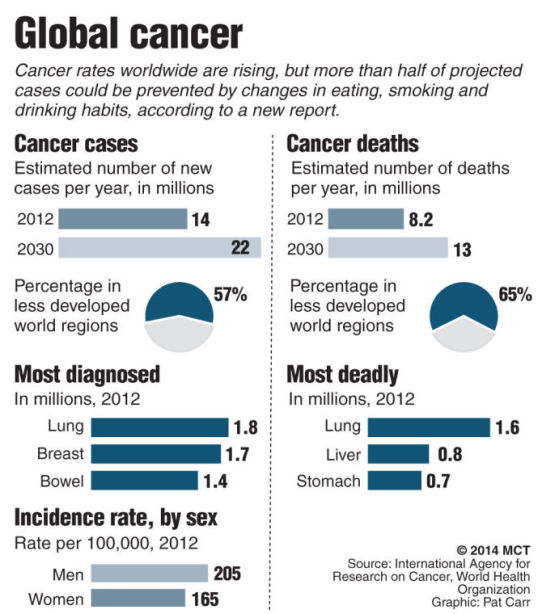Cancer on the rise
Chart based on a newly released World Health Organization report showing projected rise in cancer cases and deaths over the next 20 years, as well as differences between men and women and rich and poor countries.
Cancer is responsible for approximately 8.2 million deaths worldwide. Thirty percent of those deaths are preventable. According to the World Health Organization (WHO), global cancer rates are expected to soar from 14 million to 22 million by 2034.
One-third of cancer deaths are caused by the five leading behavioral and dietary risks: high bloody mass index, low fruit and vegetable intake, lack of physical activity, tobacco use, and alcohol use. Tobacco use, alcohol use, an unhealthy diet and physical inactivity are the main cancer risk factors worldwide.
Tobacco smoking is the number one cause of preventable death worldwide. Each year, 400,000 Americans die from smoking-related diseases. Lung cancer, which is the leading cause of cancer death, is directly attributed to smoking in 90 percent of global cancer cases. Tobacco—the single most important risk factor for cancer—causes about 71 percent of global lung cancer deaths.
Americans can decrease their risk of lung cancer by using prevention methods. The U.S. Food and Drug Administration currently offers seven approved drug medications to help smokers quit their habits. Five of those are: nicotine patches, nicotine gum and nicotine lozenges are available over the counter, and inhalers and nicotine nasal spray are available by prescription.
Because UNCW has not banned smoking campus wide—and its no smoking within a 25 foot radius policy is often ignored or unenforced—the university should make its resources more present for students struggling to break their nicotine addiction.
Rebecca Caldwell, director of Substance Abuse and Violence Prevention at CROSSROADS, explained that consultation with health professionals at the Student Health Center (located in DePaolo Hall), exploring the FDA-approved quit smoking medications, including the patch and gum, and utilizing individual services at CROSSROADS—a UNCW program aimed at promoting healthy decision-making regarding the use of alcohol, tobacco and other drugs—are all available to students who wish to quit smoking.
Electronic cigarettes, or e-cigarettes, which expel vapor rather than smoke, are also a secondary alternative to cigarette smoking, although its health risks have not yet been studied thoroughly enough by researchers.
On a global scale, lung cancer prevention begins with knowledge about the causes of cancer. On its website, the WHO states that many cancers have a high chance of cure if detected early and treated adequately. For those regions that account for 70 percent of the world’s cancer deaths—Africa, Asia, and Central and South America—screening and early detection programs are the best methods for lung cancer prevention in the predominantly lower and middle-income areas of these regions.
For now, stress relieving alternatives to cigarette smoking, such as exercise and deep meditation can help curb a smoker’s appetite from nicotine addiction.


